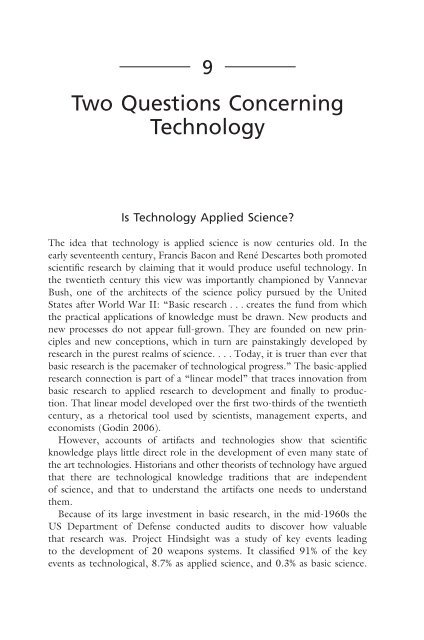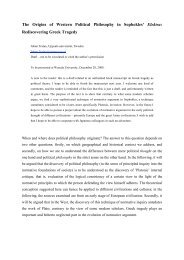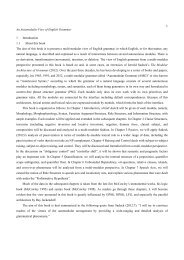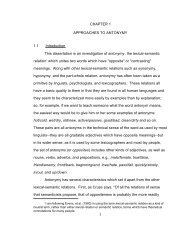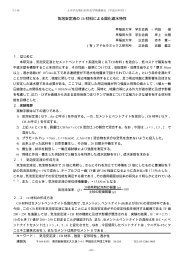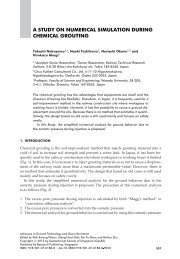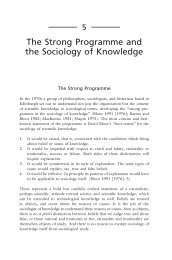Two questions concerning technology
Two questions concerning technology
Two questions concerning technology
- No tags were found...
Create successful ePaper yourself
Turn your PDF publications into a flip-book with our unique Google optimized e-Paper software.
9<strong>Two</strong> Questions ConcerningTechnologyIs Technology Applied Science?The idea that <strong>technology</strong> is applied science is now centuries old. In theearly seventeenth century, Francis Bacon and René Descartes both promotedscientific research by claiming that it would produce useful <strong>technology</strong>. Inthe twentieth century this view was importantly championed by VannevarBush, one of the architects of the science policy pursued by the UnitedStates after World War II: “Basic research . . . creates the fund from whichthe practical applications of knowledge must be drawn. New products andnew processes do not appear full-grown. They are founded on new principlesand new conceptions, which in turn are painstakingly developed byresearch in the purest realms of science. . . . Today, it is truer than ever thatbasic research is the pacemaker of technological progress.” The basic-appliedresearch connection is part of a “linear model” that traces innovation frombasic research to applied research to development and finally to production.That linear model developed over the first two-thirds of the twentiethcentury, as a rhetorical tool used by scientists, management experts, andeconomists (Godin 2006).However, accounts of artifacts and technologies show that scientificknowledge plays little direct role in the development of even many state ofthe art technologies. Historians and other theorists of <strong>technology</strong> have arguedthat there are technological knowledge traditions that are independentof science, and that to understand the artifacts one needs to understandthem.Because of its large investment in basic research, in the mid-1960s theUS Department of Defense conducted audits to discover how valuablethat research was. Project Hindsight was a study of key events leadingto the development of 20 weapons systems. It classified 91% of the keyevents as technological, 8.7% as applied science, and 0.3% as basic science.
94 <strong>Two</strong> Questions Concerning TechnologyProject Hindsight thus suggested that the direct influence of science on<strong>technology</strong> was very small, even within an institution that invested heavilyin science and was at key forefronts of technological development. A subsequentstudy, TRACES, challenged that picture by looking at prominentcivilian technologies and following their origins further back in the historicalrecord.Among historians of <strong>technology</strong> it is widely accepted that “science owesmore to the steam engine than the steam engine owes to science.” Scienceis applied <strong>technology</strong> more than <strong>technology</strong> is applied science. As we sawin the last chapter, scientific work depends crucially on tools for purifying,controlling, and manipulating objects. Meanwhile, <strong>technology</strong> may be relativelydivorced from science. Work on the history of aircraft suggests thataeronautical engineers consult scientific results when they see a need to, buttheir work is not driven by science or the mere application of science (Vincenti1990). Similarly, the innovative electrical engineer Charles Steinmetz did noteither apply physical theory or derive his own theoretical claims from it (Kline1992), but instead developed theoretical knowledge in purely engineeringcontexts. Engineers, then, develop their own mathematics, their own experimentalresults, and their own techniques.Technology is so often seen as applied science because technological knowledgeis downplayed (Layton 1971, 1974). In the nineteenth century, forexample, American engineers developed their own theoretical works on thestrength of materials, drawing on but modifying earlier scientific research.When engineers needed results that bore on their practical problems, theylooked to engineering research, not pure science. Engineers and inventorsparticipate in knowledge traditions, which shape the work that they do, especiallywork that fits into technological paradigms (Constant 1984). Science,then, does not have a monopoly on technical knowledge. The developmentof technologies is a research process, driven by interesting problems: actualand potential functional failure of current technologies, extrapolation frompast technological successes, imbalances between related technologies, and,more rarely, external needs demanding a technical solution (Laudan 1984).All but the last of these problem sources stem from within technologicalknowledge traditions.For a group of people to have its own tradition of knowledge meansthat that knowledge is tied to the group’s social networks and material circumstances.As we have seen, there is some practical incommensurabilitybetween knowledge traditions, seen in the difficulties of translating betweentraditions. In addition, some knowledge within a tradition is tacit, not fullyformalizable, and requires socialization to be passed from person to person(Chapter 10).
<strong>Two</strong> Questions Concerning Technology 95So far, we have seen arguments that technological practice is autonomousfrom science. A separate set of arguments challenge the idea that <strong>technology</strong>is applied science from almost the opposite direction. Some people workingin STS have argued that science and <strong>technology</strong> are not sufficiently welldefined and distinct for there to be any determinate relationship betweenthem. In the context of large technological systems, “persons committedemotionally and intellectually to problem solving associated with systemcreation and development rarely take note of disciplinary boundaries, unlessbureaucracy has taken command” (Hughes 1987). “Scientists” invent, and“inventors” do scientific research – whatever is necessary to move theirprogram forward.The indistinctness of science and <strong>technology</strong> can fall out of accountsof science, as well. First, “basic research” turns out to be a flexible andambiguous concept, having a history and being used in different ways(Calvert 2006): Scientists use the term in order to do boundary work, drawingon the prestige of ideals of purity to gain funding and independence.Second, for the pragmatist, scientific knowledge is about what naturalobjects can be made to do. Thus laboratory science may be seen to be aboutwhat can be constructed, not about what exists independently (Knorr Cetina1981). For the purposes of this chapter, the pragmatic orientation is relevantin that it draws attention to the ways in which science depends upon andinvolves <strong>technology</strong>, both materially and conceptually.Actor-network theory’s term technoscience eschews a principled conceptualdistinction between science and <strong>technology</strong>. It also draws attentionto the increasing causal interdependence of what is labeled science and<strong>technology</strong>. We might think it odd that historians are insisting on theautonomy of technological traditions and cultures precisely when thereis a new spate of science-based technologies and technologically orientedscience – biotechnologies, new materials science, and nano<strong>technology</strong> allcross obvious lines.Latour’s networks and Thomas Hughes’s technological systems bundle manydifferent resources together. Thomas Edison freely mixed economic calculations,the properties of materials, and sociological concerns in his designs(Hughes 1985). Technologists need scientific and technical knowledge,but they also need material, financial, social, and rhetorical resources. Evenideology can be an input, in the sense that it might shape decisions andthe conditions of success and failure (e.g. Kaiserfeld 1996). For networkbuilders nothing can be reduced to only one dimension. Technologyrequires heterogeneous engineering of a dramatic diversity of elements(Law 1987; Bucciarelli 1994). A better picture of <strong>technology</strong>, then, isone that incorporates many different inputs, rather than being particularly
96 <strong>Two</strong> Questions Concerning Technologydependent upon a single stream. It is possible that no one input is evenessential: any input could be worked around, given enough hard work,ingenuity, and other resources.To sum up, scientific knowledge is a resource on which engineers andinventors can draw, and perhaps on which they are drawing increasingly,but on the whole it is not a driver of <strong>technology</strong>. Rather, technological developmentis a complex process that integrates different kinds of knowledge –including its own knowledge traditions – and different kinds of materialresources. At the same time, science draws on <strong>technology</strong> for its instruments,and perhaps also for some of its models of knowledge, just assome engineers may draw on science for their models of engineering knowledge.There are multiple relations of science and <strong>technology</strong>, rather thana single monolithic relation. “The linear model . . . is dead” (Rosenberg1994).Does Technology Drive History?Technological determinism is the view that material forces, and especiallythe properties of available technologies, determine social events. The reasoningbehind it is usually economistic: available material resources form theenvironment in which rational economic choices are made. In addition, technologicaldeterminism emphasizes “real-world constraints” and “technicallogics” that shape technological trajectories (Vincenti 1995). The apparentautonomy of technologies and technological systems provides some evidenceof these technical logics: technologies behave differently and enter differentsocial contexts than their inventors predict and desire. If this is right, thensocial variables ultimately depend upon material ones.A few of Karl Marx and Friedrich Engels’s memorable comments onthe influence of <strong>technology</strong> on economics and society can stand in for theposition of the technological determinist, though they are certainly noteverything that Marx and Engels had to say about the determinants ofsocial structures. Looking at large-scale structures, Marx famously said “Thehand-mill gives you society with the feudal lord, the steam-mill, society withthe industrial capitalist.” Engels, talking about smaller-scale structures,claimed that “The automatic machinery of a big factory is much more despoticthan the small capitalists who employ workers ever have been.”There are a number of different technological determinisms (see Bimber1994; Wyatt 2007), but the central idea is that technological changes forcesocial adaptations, and consequently constrain the trajectories of history. RobertHeilbroner, supporting Marx, says that
<strong>Two</strong> Questions Concerning Technology 97the hand-mill (if we may take this as referring to late medieval <strong>technology</strong> ingeneral) required a work force composed of skilled or semiskilled craftsmen,who were free to practice their occupations at home or in a small atelier, attimes and seasons that varied considerably. By way of contrast, the steam-mill– that is, the <strong>technology</strong> of the nineteenth century – required a work forcecomposed of semiskilled or unskilled operatives who could work only at thefactory site and only at [a] strict time schedule. (Heilbroner 1994 [1967] )Because economic actors make rational choices, class structure is determinedby the dominant technologies. This reasoning applies to both the largestscales and much more local decisions. Technology, then, shapes economicchoices, and through them shapes history.Some technologies appear compatible with particular political and socialarrangements. In a well-known essay, Langdon Winner (1986a) asks “doartifacts have politics?” Following Engels, he argues that some complex technologicaldecisions lend themselves to more hierarchical organization thanothers, in the name of efficiency – the complexity of modern industrial productiondoes not sit well with consensus decision-making. In addition, Winnerargues, some technologies, such as nuclear power, are dangerous enoughthat they may bring their own demands for policing, and other forms ofstate power. And finally, individual artifacts may be constructed to achievepolitical goals. For example, the history of industrial automation reveals manychoices made to empower and disempower different key groups (Noble 1984):Numerical control automation, the dominant form, was developed toeliminate machinist skill altogether from the factory floor, and therefore toeliminate the power of key unions. While also intended to reduce factories’dependence on skilled labor, record-playback automation, a <strong>technology</strong> notdeveloped nearly as much, would have required the maintenance of machinistskill to reproduce it in machine form (for some related issues see Wood1982). In general, technologies are deskilling. In replacing labor they alsoreplace the skills that are part of that labor. Even a <strong>technology</strong> like a seedcan have that effect. Before hybrid corn was introduced in the 1930s, Americanfarmers were skilled at breeding their own corn, for high yield and diseaseresistance (Fitzgerald 1993). Lines of hybrid seed, though, could not becontinued on the farm, since they were first-generation crosses of inbredlines; this ensured that seed producers could sell seed every year, which wasan explicit goal. When American farmers bought high-yield hybrid seed,which they did willingly, they were delegating their breeding work to theseed companies, and setting their breeding skills aside.Even for non-determinists, the effects of technologies are important. Aswe saw in Chapter 1, a key part of the pre-STS constellation of ideas on
98 <strong>Two</strong> Questions Concerning Technologyscience and <strong>technology</strong> was the study of the positive and negative effects oftechnologies, and the attempt to think systematically about these effects. Thattype of work continues. At the same time, as we see below, some STSresearchers have challenged a seemingly unchallengeable assumption, theassumption that technologies have any systematic effects at all! In fact, theychallenge something slightly deeper, the idea that technologies have essentialfeatures (Pinch and Bijker 1987; Grint and Woolgar 1997). If technologieshave no essential features, then they should not have systematic effects, andif they do not have any systematic effects then they cannot determine structuresof the social world.No <strong>technology</strong> – and in fact no object – has only one potential use. Evensomething as apparently purposeful as a watch can be simultaneously constructedto tell time, to be attractive, to make profits, to refer to a wellknownstyle of clock, to make a statement about its wearer, etc. Even theapparently simple goal of telling time might be seen a multitude of differentgoals: within a day one might use a watch to keep on schedule, to findout how long a bicycle ride took, to regulate the cooking of a pastry, tonotice when the sun set, and so on. Given this diversity, there is no essenceto a watch. And if the watch has no essence, then we can say that it hassystematic effects only within a specific human environment.In their work on “Social Construction of Technology” (SCOT), TrevorPinch and Wiebe Bijker (1987) develop this point into a framework for thinkingabout the development of technologies. In their central example, thedevelopment of the safety bicycle, the basic design of most twentiethcenturybicycles, there is an appearance of inevitability about the outcome.The standard modern bicycle is stable, safe, efficient, and fast, and thereforewe might see its predecessors as important, but ultimately doomed, stepstoward the safety bicycle. On Pinch and Bijker’s analysis, though, the safetybicycle did not triumph because of an intrinsically superior design. Someusers felt that other early bicycle variants represented superior designs, atleast superior to the early versions of the safety bicycle with which theycompeted. For many young male riders, the safety bicycle sacrificed stylefor a claim to stability, even though new riders did not find it very stable.Young male riders formed one relevant social group that was not appeasedby the new design. Their goals were not met by the safety bicycle, as itsmeaning (to them) did not correspond well to their understanding of aquality bicycle. There is, then, interpretive flexibility in the understandingof technologies and in their designs. We should see trajectories of technologiesas the result of rhetorical operations, defining the users of artifacts,their uses, and the problems that particular designs solve. The Luddites ofearly-nineteenth-century Britain adopted a variety of interpretations of the
<strong>Two</strong> Questions Concerning Technology 99factory machines that they did and did not smash (Grint and Woolgar 1997).Although some saw the factory machines as upsetting their preferred modesof work, others saw the problem in the masters of the factories. Resistanceto the new technologies diminished when new left-wing political theoriesarticulated the machines as saviors of the working classes. The machines, then,did not have a single consistent set of effects.Interpretive flexibility can create quite unexpected results. For example, theuse of “safer sex” technologies by prostitutes shows how users can give technologiesnovel meanings, even in the service of the ends for which it is made(Moore 1997). In order to fit the contexts and culture in which prostitutesuse it, an apparently clinical latex rubber glove can become sexy by beingsnapped onto hands in the right way, or can be put to new uses by beingcut and reconfigured. Very high numbers of users modify products for theirown use, in some cases giving very new meanings to those products (vonHippel 2005).On a SCOT analysis, the success of an artifact depends upon the strengthand size of the group that takes it up and promotes it. Its definition dependsupon the associations that different actors make. Interpretive flexibility is anecessary feature of artifacts, because what an artifact does and how well itperforms are the results of a competition of different groups’ claims. Thusthe good design of an artifact cannot be an independent cause of its success;what is considered good design is instead the result of its success.Attention to users reveals the variety of relations that users and technologieshave (Oudshoorn and Pinch 2003). Among other things, users contributeto technological change, not just by adapting objects to their local needs,but also by feeding back into the design and production processes. In itsearly days the automobile was put to novel uses by farmers, for example,who turned it into a mobile source of power for running various pieces offarm machinery; their innovations contributed to the features that becamecommon on tractors (Kline and Pinch 1996). In general, lead users, thosewho are early adopters of a new <strong>technology</strong> that goes on to have wide use,and who gain considerable benefits from innovating, tend to make substantialinnovations that can be picked up by producers of that <strong>technology</strong> (von Hippel2005). This poses another problem for the linear model of innovation.A different kind of novel use of <strong>technology</strong> is the use of different ideologiesof <strong>technology</strong>. The “electromechanical vibrator” was widely sold,and advertised in catalogues, between 1900 and 1930, despite the fact thatmasturbation was socially prohibited in this period, and was even thoughtto be a cause of hysteria (Maines 2001). The vibrator could be acceptablefor sale because of its association with professional instruments, because of thehigh value attached to electric appliances in general, and because electricity
100 <strong>Two</strong> Questions Concerning TechnologyBox 9.1Digital rights managementWith the advent of digital culture, debates about copyright became louderand acquired new dimensions. Digital cultural objects such as CDs, DVDs,and MP3s can in principle be copied indefinitely many times without anydegradation. That worries many people, most importantly people in thepowerful US music and film industries. One result has been Digital RightsManagement (DRM), explored by Tarleton Gillespie in his book Wired Shut(2007). DRM is ostensibly an attempt by copyright holders to directly preventillegal, and some legal, copying, by encrypting files so that they mayonly be copied in authorized ways.By itself DRM cannot work. The history of encryption is a history ofstruggles between coders and decoders. Moreover, for DRM to work forthe cultural industries, the decryption codes must be very widely shared, orelse sales will be very limited. “The real story, the real power behind DRM,is . . . the institutional negotiations to get <strong>technology</strong> manufacturers tobuild their devices to chaperone in the same way, the legitimation to getconsumers to agree to this arrangement . . . and the legal wrangling to makeit criminal to circumvent” (Gillespie 2007: 254). And the cultural industriesin the United States have successfully convinced the US government totry to spread protection of DRM to the rest of the world through intellectualproperty negotiations.But in this social context, DRM has real effects. It prevents some copying,both legal and illegal. It gives content providers more control over the usesof their products, which may allow them to find new business models onwhich they can charge per use, for different types of uses, and can chargedifferently in different markets.was seen as a healing agent. The modernity of <strong>technology</strong>, then, could beused to revalue objects and practices.To give technologies reasonably determinate meanings requires work. Inone study, at a point well into the development process, a computer firmneeded to test prototypes of their package, to see how easy it was for unskilledusers to figure out how to perform some standard tasks (Grint and Woolgar1997). On the one hand these tests could be seen as revealing what neededto be done to the computers in order for them to be more user-friendly.On the other hand they could be seen as revealing what needed to be done
<strong>Two</strong> Questions Concerning Technology 101to the users – how they needed to be defined, educated, controlled – tomake them more computer-friendly: successful technologies require what SteveWoolgar calls configuring the user. The computer, then, does what it doesonly in the context of an appropriate set of users.Surely, though, some features of technologies are autonomous and defyinterpretation. We might, for example, ask with Rob Kling (1992) “What’sso social about being shot?” Everything, say Grint and Woolgar. In a tourde-forceof anti-essentialist argumentation, Grint and Woolgar argue thata gun being shot is not nearly as simple a thing as it might seem. It is clearthat the act of shooting a gun is intensely meaningful – some guns are, forexample, more manly than others. But more than that, even injuries by gunshotcan take on different meanings. When female Israeli soldiers were shotin 1948, “men who might have found the wounding of a male colleaguecomparatively tolerable were shocked by the injury of a woman, and the missiontended to get forgotten in a general scramble to ensure that she receivedmedical aid” (Holmes, quoted in Grint and Woolgar 1997). Even death isnot so certain. Leaving aside common uncertainties about causes of deathand the timing of death, there are cross-cultural differences about death andwhat happens following it. No matter how unmalleable a <strong>technology</strong> mightlook, there are always situations, some of them highly hypothetical, in whichthe <strong>technology</strong> can take on unusual uses or interpretations. In addition, technologiesare not as autonomous as they often appear. Some of the appearanceof autonomy in a <strong>technology</strong> stems from of our lack of knowledge.As we gain knowledge of the historical paths of particular trajectories, wesee more human roles in those paths (Hong 1998).To accept that technologies do not have essences is to pull the rug outfrom under technological determinism. If they do nothing outside of thesocial and material contexts in which they are developed and used, technologiescannot be the real drivers of history. Rather these contexts are inthe drivers’ seats. This recognition is potentially useful in enabling politicalanalyses, because particular technologies can be used to affect social relations(Hård 1993), such as labor relations (e.g. Noble 1984) and gender relations(e.g. Cockburn 1985; Cowan 1983; Oudshoorn 2003).There should, then, be no debate about technological determinism.However, in practice nobody holds a determinism that is strict enoughto be completely overturned by these arguments. Even the strictest ofdeterminists admit that social forces play a variety of important roles inproducing and shaping <strong>technology</strong>’s effects. Such a “soft” determinism isan interpretive and heuristic stance that directs us to look first to technologicalchange to understand economic change (Heilbroner 1994 [1967] ).Choices are made in relation to material resources and opportunities. To
102 <strong>Two</strong> Questions Concerning Technologythe extent that we can see social choices as economic choices, <strong>technology</strong>will play a key role.Anti-essentialists show us that even soft determinism must be understoodwithin a social framework, in that the properties of technologiescan determine social structures and events only once the social world hasestablished what the properties of technologies are. Anti-essentialism directsus to look to the social world to understand technological change and itseffects. This is perhaps most valuable for its constant reminder that thingscould be different.On the other hand, we study <strong>technology</strong> because artifacts appear to dothings, or at least are made to do things. Thus a limited determinism is right,given a particular set of actions within a particular social and materialarrangement. “Our guilty secret in STS is that really we are all technologicaldeterminists. If we were not, we would have no object of analysis”(Wyatt 2007).Bijker’s theory of sociotechnological ensembles is an attempt to understandthe thorough intertwining of the social and technical (Bijker 1995). Bijkerdraws heavily on work on <strong>technology</strong> as heterogeneous engineering, andon his earlier work with Pinch on SCOT. A key concept in the theory is thatof the technological frame, the set of practices and the material and socialinfrastructure built up around an artifact or collection of similar artifacts –a bit like Kuhn’s paradigm. Another, similar concept is the notion of atechnological script, developed from within actor-network theory (Akrich1992). As the frame is developed, it guides future actions. A technologicalframe, then, may reflect engineers’ understandings of the key problemsof the artifact, and the directions in which solutions should be sought.Technological frames also reproduce themselves, when enough physicalinfrastructure is built around and with them. The “system of automobility”(Urry 2004), for example, has been and continues to be very durable, giventhe enormous physical, political, and social infrastructure, on both local andglobal scales, based on cars made of steel that use petroleum.A technological frame may also reflect understandings of the potential usersof the artifact, and users’ understanding of its functions. If a strong technologicalframe has developed, it will cramp interpretative flexibility. Theconcept is therefore useful in helping to understand how technologiesand their development can appear deterministic, while only appearing so inparticular contexts. For example, in recent decades research on contraceptionhas concentrated on female contraception. This gender asymmetry andthe assumptions behind it are constituted by negotiations, choices, andcontingencies. As a result, new male forms of contraception depend on alternativesociotechnical ensembles. Ultimately, their success will depend on cultural
<strong>Two</strong> Questions Concerning Technology 103work to reshape the features of gender that contribute to the asymmetry,and to which the available technologies contribute (Oudshoorn 2003).Stretching the concept a little, we might see how technological framescan highlight some features of technologies and hide others. In the nineteenthcentury governments and banks went to extensive efforts to protectpaper currency from forgery. Exquisite engravings, high-quality paper andink, and consistent printing processes gave users of paper money moreconfidence that it was genuine. In principle those features of paper moneycould not serve to answer doubts about the solidity of paper currency –in comparison to coins containing precious metals – even if the banknoteas a work of art had the effect of distracting from those doubts (Robertson2005).Architecture provides a good example of the ways in which technologieshave effects and embody social structure. A building is a piece of <strong>technology</strong>,one that shapes the activities, interactions, and flows of people. Forexample, a study of the design and use of a university bio<strong>technology</strong> buildingshowed some of the negotiations incorporated into the building: itwill have space for visiting industrial scientists, but not for undergraduatestudents; it will integrate molecular biology, genetics, and biochemistry, butseparate molecular biology from microbiology (Gieryn 2002). Once thesedecisions are made, the (literally) concrete structure forms a concrete socialstructure. Yet, there is more flexibility than designers intended: the unusedlabs for visiting industrial scientists eventually become academics’ labs; andsome teaching of undergraduate students takes place in research labs. Thebuilding becomes reinterpreted.Even if technologies do not have truly essential forms – properties independentof their interpretations, or functions independent of what they aremade to do – essences can return, in muted form. Artifacts do nothing bythemselves, though they can be said to have effects in particular circumstances.To the extent that we can specify the relevant features of their material andsocial contexts, we might say that technological artifacts have dispositionsor affordances. Particular pieces of <strong>technology</strong> can be said to have definitiveproperties, though they change depending upon how and why they are used.Material reductionism, then, only makes sense in a given social context, justas social reductionism only makes sense in a given material context.Does <strong>technology</strong> drive history, then? History could be almost nothing withoutit. As Bijker puts it, “purely social relations are to be found only in theimaginations of sociologists or among baboons.” But equally, <strong>technology</strong>could be almost nothing without history. He continues, “and purely technicalrelations are to be found only in the wilder reaches of science fiction”.(Bijker 1995).
104 <strong>Two</strong> Questions Concerning TechnologyBox 9.2Were electric automobiles doomed to fail?David Kirsch’s history of the electric vehicle illustrates both the difficulty andpower of deterministic thinking (Kirsch 2000). The standard history of theinternal combustion automobile portrays the electric vehicle as doomed tofailure. Compared with the gasoline-powered vehicle, the electric vehiclesuffered from lack of power and range, and so could never be the allpurposevehicle that consumers wanted. However, “technological superioritywas ultimately located in the hearts and minds of engineers, consumers, anddrivers, not programmed inexorably into the chemical bonds of refinedpetroleum” (Kirsch 2000: 4).Until about 1915 electric cars and trucks could compete with gasolinepoweredcars and trucks in a number of market niches. In many ways electriccars and trucks were successors to horse-drawn carriages: Gasoline-poweredtrucks were faster than electric trucks, but for the owners of delivery companiesspeed was more likely to damage goods, to damage the vehicles themselves,and in any case was effectively limited in cities. Because they wereeasy to restart, electric trucks were better suited to making deliveries thanearly gasoline-powered trucks; this was especially true given the horse-pacedrhythm of existing delivery service, which demanded interaction betweendriver and customer. Electric taxis were fashionable, comfortable, and quiet,and for a time were successful in a number of American cities, so much sothat in 1900 the Electric Vehicle Company was the largest manufacturer ofautomobiles in the United States.As innovators, electric taxi services were burdened with early equipment.Some happened to suffer from poor management, and were hit by expensivestrikes. They failed to participate in an integrated urban transit system thatlinked rail and road, to create a niche they could dominate and in whichthey could innovate. Meanwhile, Henry Ford’s grand experiment in producinglow-cost vehicles on assembly lines helped to spell the end of the electricvehicle. World War I created a huge demand for gasoline-powered vehicles,better suited to war conditions than were electric ones. Increasing suburbanizationof US cities meant that electric cars and trucks were restrictedto a smaller and smaller segment of the market. Of course, that suburbanizationwas helped along by the successes of gasoline, and thus thedemands of consumers not only shaped, but were shaped by automobiletechnologies.In 1900 the fate of the electric vehicle was not sealed. Does this failureof technological determinism mean that electric cars could be rehabilitated?
<strong>Two</strong> Questions Concerning Technology 105According to Kirsch, writing in the late 1990s, that seemed unlikely. Materialand social contexts have been shaped around the internal combustionengine, and it seemed unlikely that electric cars could compete directly withgasoline cars in these new contexts. Yet, only a few years later, it appearsthat there may be niches for electric cars, created by governments’ and individuals’commitment to reducing greenhouse gases.


